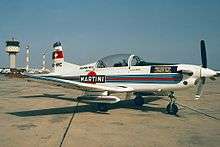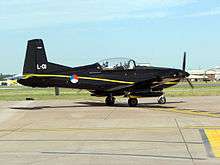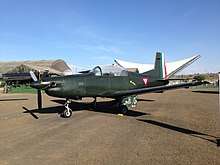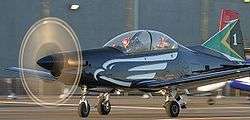Pilatus PC-7
| PC-7 | |
|---|---|
 | |
| Role | Light trainer aircraft |
| Manufacturer | Pilatus Aircraft |
| First flight | 12 April 1966 (prototype) 18 August 1978 (production) |
| Introduction | 1978 |
| Status | In service, in production |
| Primary users | Indian Air Force Mexican Air Force South African Air Force Royal Malaysian Air Force |
| Produced | 1966–present |
| Number built | >618 |
| Developed from | Pilatus P-3 |
| Variants | Pilatus PC-9 |
The Pilatus PC-7 Turbo Trainer is a low-wing tandem-seat training aircraft, manufactured by Pilatus Aircraft of Switzerland. The aircraft is capable of all basic training functions including aerobatics, instrument, tactical and night flying. It has been selected by more than 20 air forces as their ab initio trainer. Since the aircraft's introduction in 1978, close to 500 have been sold, with the majority still in service. Over one million hours have been flown by PC-7s worldwide.
Development
The PC-7 is based on the earlier piston-powered Pilatus P-3. The first prototype, modified from the prototype P-3 by replacing its Lycoming O-435 engine with a Pratt & Whitney PT6A-20 turboprop, flew on 12 April 1966, but after a crash the PC-7 programme was shelved.[1]
In 1973, the programme was restarted and another P-3 was obtained from the Swiss Air Force. After modification, this aircraft flew on 12 May 1975. Further extensive modifications followed later in the programme, including a new one-piece wing with integral fuel tanks, an altered tailfin and a bubble canopy.

The first production aircraft flew on 12 August 1978. Swiss civil certification followed on 5 December of the same year, with deliveries, to Burma and Bolivia starting immediately thereafter.[2]
The aircraft is also used by private customers and is both FAA and FOCA civil certified to comply to the general aviation regulations in Europe and the USA.
The PC-7 Mk II is a development of the PC-9's airframe and avionics, fitted with the PC-7's smaller turbine to lower operating and maintenance costs. It is used by the South African Air Force, with sixty examples having been manufactured. The aircraft were assembled in South Africa from kits supplied by Pilatus. The value of the contract was estimated to be 175 million USD in 1993. Due to political considerations, the aircraft were not fitted with the armament hardpoints. Four PC-7 Mk II aircraft are used by the air force of Brunei.
Operational history
The Chadian Air Force has used its small fleet of PC-7s to bomb rebel positions both in their own territory and in neighbouring Sudan.[3]
PC-7s were employed by the Guatemalan Air Force in air strikes and for close air support during the Guatemalan civil war, starting in 1982 until the end of the conflict in 1996. The PC-7s deployed from the airfield in La Aurora armed with gunpods and light rocket launchers.[4]
In 1994, Mexican Air Force armed PC-7s were used to attack Zapatista Army of National Liberation during the Chiapas conflict in Mexico. This action was considered illegal by the Swiss government because the airplanes were sold for training purposes only, and as result, Switzerland issued a ban to sell more units to Mexico.[5]
In the mid to late 1990s, Executive Outcomes, a private military contractor (PMC) led by Eben Barlow, utilised three armed PC-7s (ex-Bophuthatswana Air Force aircraft) to provide close air support during its operations in Sierra Leone.[6]
In June 2011, the Indian Air Force selected the Pilatus PC-7 MkII trainer as its basic trainer, an initial order of 75 was made.[7] This order could be progressively increased to 181 trainers after technology transfer to India. The Indian cabinet approved the deal to buy the trainer.[8] The contract was signed on 24 May 2012. As of 20 March 2014 the Indian MOD requested additional information for another 175 aircraft.[9]
Variants
- PC-7 : two-seat basic trainer aircraft, powered by PT6A-25A engine rated at 410 kW (550 shp).[10]
- PC-7 Mk II is a development of the PC-9's airframe and avionics, retaining the PC-7's wing to mount external stores. Powered by PT6A-25C of 522 kW (700 shp) rather than more powerful PT6A-62 of PC-9.[11] Developed for the SAAF, and known as the "Astra"; the aircraft is a hybrid PC-7 and PC-9, either a PC-7 "Heavy" or a PC-9 "Lite" depending on point of configuration.[12]
- NCPC-7 : upgraded version of the standard PC-7 with fully IFR glass cockpit avionics, developed for the Swiss Air Force.
Operators
Military operators

An incomplete list of the users of the PC-7:[13]
- National Air Force of Angola: 25 (delivered from 1982)
- Austrian Air Force: 16 (delivered from 1983)
- Bolivian Air Force: 24 (delivered from 1979)
- Botswana Defence Force Air Wing: seven (delivered from 1990) to be replaced by five PC-7 Mk 2s in 2013.[14] Five PC-7 Mk II aircraft formally accepted into service on February 8, 2013, removing six PC-7s from service.[15]
- Royal Brunei Air Force: has four (PC-7 Mk 2). The type is also used by the Alap-Alap Formation aerobatic display team.
- Chad Air Force: has two (delivered from 1985)
- Chilean Navy: ten (delivered from 1980)
- Five (delivered 1991)

- Guatemalan Air Force: 12 (delivered from 1980)
- Indian Air Force: 75, as of April 2014 some 35 PC-7 Mk II have been delivered,[16] with 40 more on order; to be delivered at the rate of about two aircraft every month.[17][18][19] The Indian Ministry of Defence wants to buy an additional 106 basic trainer aircraft from Pilatus that would be licence-built by a domestic company.[20]
- Iran Air Force: 35 (delivered from 1983)
- Royal Malaysian Air Force: 30 PC-7 Turbo Trainers out of a first order of 44 (delivered from 1983), 17 PC-7 Mk IIs out of a second order of 19 (delivered in two batches, nine from 2001 and ten from 2007). Total of 47 currently in service. The type is also used by the Taming Sari aerobatic display team.
- Mexican Air Force: 88 (first delivery May 1979)[21]
 Pilatus PC-7 aircraft in the Mexican Air Force.
Pilatus PC-7 aircraft in the Mexican Air Force.
- Myanmar Air Force: 17 (delivered from 1979)
- Royal Netherlands Air Force: 13 (delivered from 1989). The type is also used by the Solo Display Team aerobatic display team.
- South African Air Force: 60 (PC-7 Mk 2s). The type is also used by the Silver Falcons aerobatic display team.
- Swiss Air Force: 40 (delivered from 1979), 28 NCPC-7s in service in 2011.[22] The type is also used by the PC-7 Team aerobatic display team.
- United Arab Emirates Air Force: 30 delivered, 30 in service.
- Uruguayan Air Force: six (delivered from 1992)
Former military operators
- Three (delivered from 1989, later transferred to South Africa and subsequently served in the Sierra Leone civil war and Chad)
.svg.png)
- Iraq Air Force: 52 (delivered from 1980)
- Nigerian Air Force had two aircraft in service.
- Surinam Air Force: three (delivered from 1985)
Former civil operators
Accidents and incidents
The South African Air Force (SAAF) grounded their fleet of PC-7 MkIIs after a crash on 15 January 2008. The aircraft went down shortly after takeoff from Overberg Air Force Base in the Western Cape Province. SAAF Lieutenant-Colonel Chris Meiring, 58, died shortly after the crash. The aircraft was flying to Langebaanweg Air Force Base for maintenance but shortly after takeoff it rolled and flew into the ground. The cause is believed to have been a structural problem.

In November 2009, a civilian passenger in the back seat of a South African Air Force Pilatus PC-7 MK II ejected from the aircraft while in flight. The civilian accidentally pulled the yellow and black ejection lever while trying to brace himself. The passenger is thought to be a friend of the pilot, Captain Gerhard Lourens of the Silver Falcons. Civilians are not usually allowed in SAAF aircraft equipped with ejector seats. An air force spokesman confirmed that officials had launched an investigation into the accident. The passenger survived the incident.[23]
In March 2010, a pilot was killed when his Royal Malaysian Air Force (RMAF) aircraft exploded and caught fire in midair during a solo airshow. This is the fifth accident involving Royal Malaysian Air Force PC-7 aircraft.[24]
In June 2010, two Mexican pilots were killed when their Air Force PC-7 crashed after taking off from Pie de la Cuesta, a district in the resort city of Acapulco, Mexico. The PC-7 crashed into the sea near Acapulco.[25][26]
On 20 October 2011, two PC-7s of the Botswana Defence Force were involved in a midair collision over Letlhakeng 100 km west of Gaborone. Two of the four aircrew involved were killed in the accident.[27]
On 12 September 2017 a pilot was killed when his Swiss Air Force PC-7 crashed at the Schreckhorn in Canton Bern on its way from Payerne AFB to Locarno AFB.[28]
Specifications (PC-7 Turbo Trainer)
Data from [29]
General characteristics
- Crew: two, student and instructor
- Length: 9.78 m (32 ft 1 in)
- Wingspan: 10.40 m (34 ft 1 in)
- Height: 3.21 m (10 ft 6 in)
- Wing area: 16.60 m² (179.0 ft²)
- Empty weight: 1,330 kg (2,932 lb)
- Max. takeoff weight: 2,700 kg (5,952 lb)
- Powerplant: 1 × Pratt & Whitney Canada PT6A-25A turboprop, 410 kW (550 shp) [30]
Performance
- Never exceed speed: 500 km/h (270 knots, 310 mph)
- Maximum speed: 412 km/h (222 knots, 256 mph) (max cruise at 6,100 m (20,000 ft))
- Stall speed: 119 km/h (64 knots, 74 mph) flaps and gear down, power off
- Range: 2,630 km (1,420 nmi, 1,634 mi) (cruise power, at 5,000 m (16,400 ft) - 20 min reserves)
- Service ceiling: 10,060 m (33,000 ft)
- Rate of climb: 10.9 m/s (2,150 ft/min)
- Wing loading: 114.5 kg/m² (23.44 lb/ft²)
Armament
- Hardpoints: 6 × hardpoints for bombs and rockets with a capacity of 1,040 kg (2,294 lb)[31]
See also
Related development
Aircraft of comparable role, configuration and era
- Atlas ACE
- Beechcraft T-34 Mentor
- Diamond DART 450
- Embraer EMB 312 Tucano
- Grob G 120TP
- HAL HTT-40
- PZL-130 Orlik
- Socata TB 30 Epsilon
- TAI Hurkus
References
Notes
- ↑ Air International September 1979, p. 112.
- ↑ Air International September 1979, p. 114.
- ↑ Wezeman, Pieter D. "Arms flows to the conflict in Chad." Archived 2 June 2013 at the Wayback Machine. sipri.org, August 2009. Retrieved: 9 November 2012.
- ↑ Cooper, Tom. "Guatemala since 1954". ACIG.org. Retrieved 31 January 2013.
- ↑ Aranda, Jesús. "Ahora que la FAM pretende renovar su flota no puede adquirir aviones Pilatus C-9" (in Spanish). La Jornada. 13 November 2009. Retrieved: 9 November 2012.
- ↑ Barlow, Eben. "Executive Outcomes: Against all Odds." Archived 29 December 2007 at the Wayback Machine. galago.co. Retrieved: 9 November 2012.
- ↑ Pilatus Press Release. "India Selects Pilatus Basic Trainer." LiveFistDefence.com, 24 May 2012. Retrieved: 19 June 2011.
- ↑ "India closes in on Pilatus acquisition." Janes, 4 May 2012.
- ↑ http://www.airforce-technology.com/news/newsindian-mod-to-buy-additional-106-pilatus-pc-7-mk-ii-basic-trainer-aircraft-4200297%5Bunreliable+source?%5D
- ↑ Air International September 1979, p. 115.
- ↑ Taylor 1999, pp. 96–97.
- ↑ "Pilatus PC-7." militaryaviation.eu. Retrieved: 9 November 2012.
- ↑ "Pilatus PC-7 list of users." militaryaviation.eu. Retrieved: 9 November 2012.
- ↑ "Botswana Defence selects PC-7 MkII turboprop trainer aircraft worth SF 40 Mil." Archived 25 April 2011 at the Wayback Machine. frontierindia.net. Retrieved: 9 November 2012.
- ↑ Botswana introduces new PC-7 MkII trainers - Flightglobal.com, February 11, 2013
- ↑ "Archived copy" (PDF). Archived from the original (PDF) on 14 September 2014. Retrieved 14 September 2014.
- ↑ "India signs 500 M Swiss francs contract for Pilatus PC-7 MKII." Archived 4 November 2012 at the Wayback Machine. Bharat-Rakshak.com. Retrieved: 9 November 2012.
- ↑ "IAF's first Swiss Pilatus trainer aircraft arrives in India". The Hindu. 30 May 2013. Retrieved 1 June 2013.
- ↑ "AFA Dundigal gets Swiss jet trainer Pilatus PC-7 Mk-II". Deccan Chronicle. 3 February 2013. Retrieved 3 February 2013.
- ↑ "India Wants Domestic Production of Pilatus Trainers". DefenseNews. 2014-04-21. Retrieved 2014-05-07.
- ↑ Jackson 2003, p. 454.
- ↑ "Pilatus NCPC-7." Archived 22 February 2012 at the Wayback Machine. Swiss Air Force. Retrieved: 9 November 2012.
- ↑ Maclean, Sean. "Oops! Civilian in joyride accidentally grabs ejection lever but lands safely." Daily Mail, 2 November 2009. Retrieved: 9 November 2012.
- ↑ "Nasional Karnival konvokesyen UUM bertukar tragedi." bharian.com, 26 March 2010. Retrieved: 9 November 2012.
- ↑ "Cae avión militar en Acapulco" (in Spanish). El Debate. Retrieved: 6 May 2013.
- ↑ "Two Die in Military Plane Crash in Mexico." Latin American Herald Tribune. Retrieved: 6 May 2013.
- ↑ "Two BDF planes collide, killing two pilots." Mmegi online. Retrieved: 9 November 2012.
- ↑ PC-7 crash on Schreckhorn
- ↑ Lambert 1993, pp. 359–360.
- ↑ Normal rating of PT6A-25A 485 kW (650 shp) - flat rated to 410 kW (550 shp) in PC-7 installation
- ↑ Air International September 1979, p. 113.
Bibliography
- Jackson, Paul. Jane's All The World's Aircraft 2003–2004. Coulsdon, UK: Jane's Information Group, 2003. ISBN 0-7106-2537-5.
- Lambert, Mark. Jane's All The World's Aircraft 1993-94. Coulsdon, UK: Jane's Data Division, 1993. ISBN 0-7106-1066-1.
- "The Svelte Switzer ... Pilatus' Turbo Trainer". Air International, Vol. 16, No. 3, September 1979, pp. 111–118.
External links
| Wikimedia Commons has media related to Pilatus PC-7. |